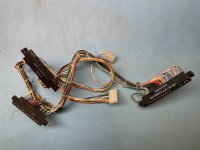@maceffectsThe model is A6S0300 with memory option A6S0304.
Do you know what the "Applenet" number refers to?
The Lisa contains two serial numbers inside the VSROM - one is the serial number of the Lisa itself, the 2nd is the AppleNet ID which is sort of like a MAC address in modern ethernet cards. These latter ones were to be used with the proprietary AppleNet network cards to identify a Lisa on an AppleNet network.
You can see these values by powering on your Lisa, not inserting a floppy, then telling the Lisa to boot off the floppy drive. When it throws an error saying insert a floppy, press Apple-Shift-S to get into service mode, and then select "1" to display memory and then type in 240 for the address and I think 80 or 40 for the count. (off the top of my head). The first 32 bytes are the serial number, the 2nd are the AppleNet ID. These sometimes match the physical sticker on the chassis, unless ofc the CPU board has been moved from another Lisa, etc. Lisas with the 3A Video modification kit do not have any serial numbers and will display zeros in this location.
While a few prototype AppleNet cards and hubs were created these never went to market, and instead Apple switched to using the built in serial port at ~223Kbps AppleTalk, which later changed to use RJ11 phone wires, called PhoneNet. Eventually when Ethernet became available, they ran the same AppleTalk over ethernet and called it "EtherTalk" and renamed the older AppleTalk protocol to "LocalTalk". EtherTalk used a slightly different signalling scheme
CSMA/CA vs
CSMA/CD to avoid collisions, unlike normal ethernet, which basically sent a short reservation topic (sort of like raising your hand before you speak) which silenced all the other workstations for a short period of time.
Neither forms of AppleTalk were based on AppleNet, and we don't really know what the AppleNet software looks like as it hasn't surfaced. Tom Stepleton has created dumps and reverse engineered schematics of these AppleNet cards here:
https://github.com/stepleton/applenet
It may be possible that the same folks that worked on AppleNet designed AppleTalk, or it may be competing teams that built something completely different. We don't know. There's no software for these, unless you count the boot ROM on the AppleNet cards, which would have allowed a Lisa to boot off an AppleNet network.
You can find some general details here:



